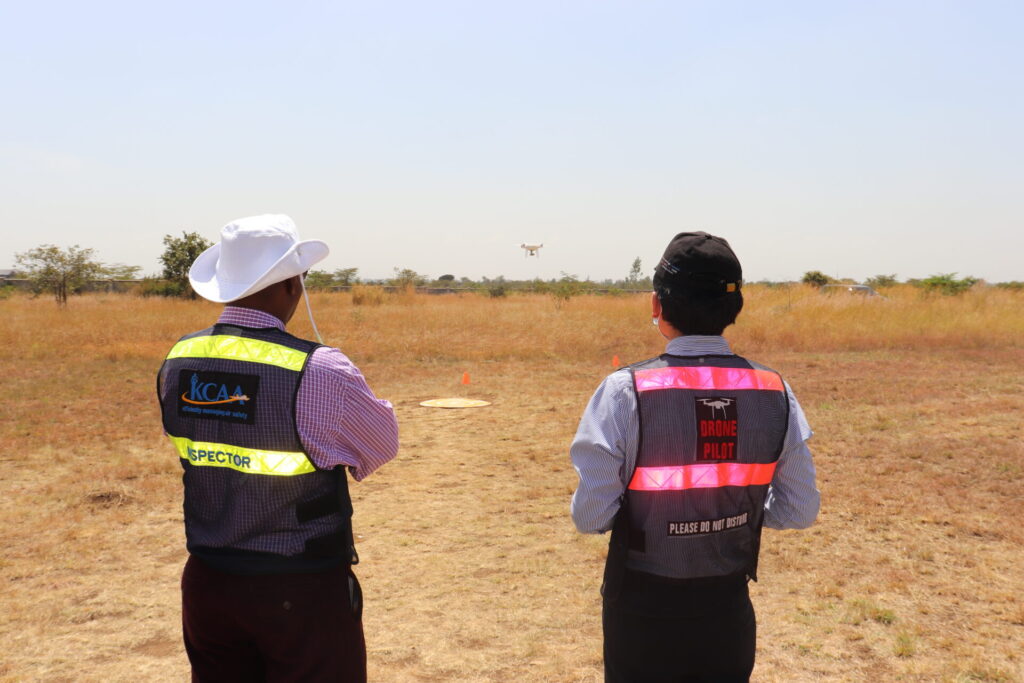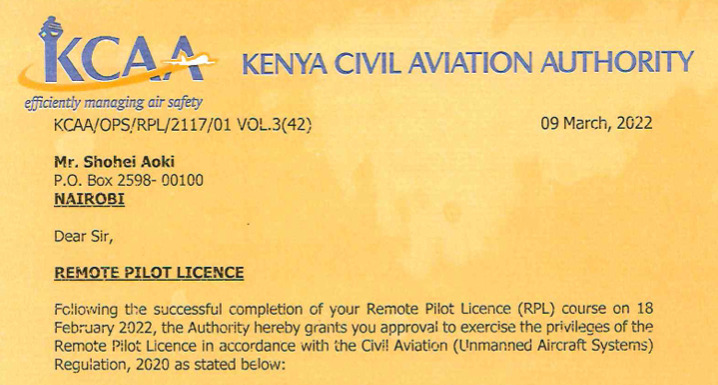Get a drone license in Kenya
In Kenya, drone flights are allowed with the pilot license. The penalties for violations are severe, with a fine of 2 million shillings (about 2 million Japanese yen) for flying without a pilot’s license (called an RPL). This sounds very expensive and even impossible, but in addition to this, flying a drone that is not registered with the Civil Aviation carries an additional 2 million shillings (Wow!). Moreover, if a drone is flown for commercial purposes, such as commercial aerial photography, a separate license (ROC) must be obtained, and a fine of 2 million shillings is also imposed for violations in case of the lack of this license. In conclusion, the maximum fine reaches approximately 6 million.
As of May 2022, there are 7 UTOs in Kenya and they have produced 300 licensed drone pilots (see: Licensed drone pilots rise to 300 – Business Daily (businessdailyafrica.com). The license training takes about two weeks and costs in the range of 160k to 200k shillings, according to a couple of quotations I obtained. Although it is not at a level where travelers can easily apply for a license, it is possible to obtain a license even if you are not a resident of Kenya. The RPL requires applicants to be 1) at least 18 years old, 2) able to read, write, and speak English, and 3) hold a Class 3 medical certificate, and does not require Kenyan residency. On the other hand, the rule that drone aircraft registration is limited to Kenyan residents makes it difficult for short-term visitors to fly a drone in Kenya unless they borrow a drone registered in Kenya (this is my personal understanding, so if you have any doubts, please contact the Kenya Civil Aviation Authority).
After 2020, when the new Civil Aviation Act was put into effect, drones are to be brought into Kenya through the proper import procedures. According to an acquaintance who has actually had a drone confiscated, the drone is stored in a warehouse and will be returned upon departure from Kenya with a storage fee. Drones brought into Kenya before 2020, when the law was enforced, can be used if they are registered with the Civil Aviation Authority. I myself brought two drones into Kenya before such an act was put into effect, so I asked a company to register my drones under the Civil Aviation. Registration can also be done by individuals at the following website: https://rpas.kcaa.or.ke/ . The registration fee is 3,000 shillings per drone. It seems that we can also initiate the import procedures of the drones from this website.
Class 3 medical certificate can be issued by an aviation doctor. I visited a clinic in South C of Nairobi. This medical checkup is basically for the employees who work in the aviation industry. For your information, Class 1 is for pilots of passenger aircraft, Class 2 for cargo aircraft and private jets, and Class 3 for air traffic controllers and drone pilots. When we visited the clinic, several people who seemed to be in the aviation industry were undergoing medical checkups.
- Questionnaire (Does anyone in the family have high blood pressure or diabetes?)
- Color blindness test (Ishihara method)
- Blood pressure
- Stethoscope
- Visual check of the ear
- Visual check of eyes
- Visual check of mouth
- Vision test
- Height and weight measurement
- EKG
- Urinalysis (diabetes)
- HIV blood test
- Chest X-ray
Personally, I was amused to take an HIV test for the first time in my life. But I still don’t know why it is necessary. Some of my friends guessed it is because the HIV weakens the immune system and hinders the operation of the aircraft.
After obtaining a medical certificate, the applicant actually goes to a training school (UTO) to complete registration. The standard schedule seems to be five days of classroom training and five days of flight training. The classroom training mainly covers the following topics
- Air law
- Flight planning
- Human performance
- Meteorology
- Navigation
- Theory of flight
- Battery Procedure
- Radio telephony (out of scope of the exam)
I had to pass the exam in the classroom, but it was not easy because I could only take some of the lectures due to the tight schedule so the rest I needed to study by myself using the lecture slides and the practice exams. The exam consisted of multiple choice questions (100 questions in total) and lasted 3 hours. I was allowed to leave early after the first 20-30 minutes of the exam, so I don’t remember the detailed exam duration. It might have been 2 hours. The minimum required score was 70. The examiner was present in the exam room, and the students’ activities were thoroughly recorded while answering the questions. Apparently, they record for the purpose of compliance with the Civil Aviation.
In flight training, a total of 300 minutes of accumulated flight time must be achieved. 300 minutes(= 5 hours) may sound short, but it is actually not. One hour of flying a drone in Kenya, where the sun is very strong, can be quite exhausting. As each battery lasts less than 20 minutes (about 18~19 minutes), you start to feel fatigue after just three flights. At the end of the day, I found it hard to stand holding the controller, so I was wishing to end the work as soon as possible.
The flight training focuses on mastering manual operations using a controller, and does not deal with any waypoint flights in which the pilot checks the camera image on the app or specifies the flight path using GPS. They insist on manual flight training although the drones are normally flown automatically using an app, since pilots are required to have the skills to safely return the aircraft to the ground in the event of an emergency. The aircraft used for flight training were the Phantom 3 and Phantom 4. In the beginning, I was given the Phantom 3 all the time, so when I was allowed to use the Phantom 4, I was surprised at its much better attitude stability.
The basic content of the flight training is to move on the sides of the triangular cones placed at the four corners (Horizontal Box). There are two types of flight training: Tail in Hover and Directional flight. The difference is whether or not the drone’s yaw direction is changed (Tail in Hover is to keep looking at the drone’s back, Directional flight is to turn it in the yaw direction). There are two additional challenges. The first is the point of interest, which is a smoother version of the Horizontal Box (Directional flight), where the object is in the center of the cone and the camera keeps shooting while circling it. The other one, whose name I have forgotten, is a movement in which the camera rises sharply forward at 45 degrees and then descends back at 45 degrees. I struggled with this task at first. Flying the drone forward was easy, but I had a challenge for descending the drone at 45 degrees.
After completing the prescribed hours of flight training, an on-site examination is conducted by a flight examiner from the Civil Aviation. Although the it is called an exam, it is unlikely that the applicants will be dropped at this point. But if they crash a drone or their flight controls are too unstable, their training have to be redone. There is also an oral exam before the practical exam. According to the information provided by the school instructor, if you cannot answer a question, someone else can answer on your behalf since it is a group test… In reality, this was not the case. When they asked me about the METAR (weather forecast code), I confused the part showing temperature/dew point with the TAF forecast period. And no one was guided to assist me. Anyway, our group with four students was questioned for about 40 minutes, and we were finally let go.
The flight examiner instructed us to report the current status of the flight area, check the condition of the aircraft, turn on the power, perform basic operations of the aircraft, the horizontal box, point of interest, and 45-degree ascent and descent. In addition to this, I was also requested to perform an automatic landing, assuming that I had lost sight of the aircraft. My turn was relatively easy because I was the fourth out of four examinees.

After all the steps are completed, a certificate is issued by the Civil Aviation.

RPL is valid for two years and must be renewed every two years. Class 3 Medical certificate is also valid for 2 years.
By the way, I have not yet flown a drone once since I obtained my RPL. I expect that I will have more opportunities to fly it in the future as the research groups on campus become more active.